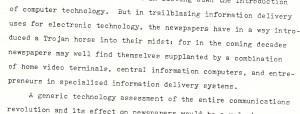At the end of an otherwise reasonable column about the Iranian uprising Peggy Noonan went off the deep end again yesterday. First she unleashed her inner Edmund Burke, dialing the Wayback Machine to the 1790s to try to reimagine the excesses of the French Revolution ricocheting around the world via Twitter. She asks, “Would Thomas Jefferson have been able to continue his blithe indifference if reports of France grimly murdering France had been Twittered out each day?” Hey, Tom — forget about the allies who just helped you win independence. Never mind your own revolutionary experience. Disavow those tumbrels!
This spasm of Noonanity is immediately followed by another, even sillier one, an observation on the inconsiderate naming habits of technological innovators:
The great question is what modern technology can do not in the short term so much as the long. It is not the friend of entrenched tyranny. Connected to which, it would be nice if the technologies of the future were not given babyish names. Twitter, Google, Facebook, etc., have come to be crucial and historically consequential tools, and yet to refer to them is to talk baby talk. In the future could inventors please keep the weight and dignity of history in mind?
That’s right, Sergei and Larry, Ev and Biz, Zuckerberg et al: Listen to your old aunt Peggy. Stop making fools of yourselves. Every time you give one of your companies a wacky name, you are sabotaging the gravitas of pundits everywhere. Just stop it, kids, now: you’re making the talking heads look silly!

 I was cleaning out my garage recently, combing through some old files, and stumbled on a research paper I wrote in 1981 as a senior in college. The title was “The Electronic Newsroom and the Video Display Terminal.” I was writing about the moment that the digital transition rolled out from the back shop to engulf the newsroom, as — almost overnight — the typewriters were put out to pasture and a generation of journalists learned to love cut/paste and the “delete” key. What would that mean for the future of news?
I was cleaning out my garage recently, combing through some old files, and stumbled on a research paper I wrote in 1981 as a senior in college. The title was “The Electronic Newsroom and the Video Display Terminal.” I was writing about the moment that the digital transition rolled out from the back shop to engulf the newsroom, as — almost overnight — the typewriters were put out to pasture and a generation of journalists learned to love cut/paste and the “delete” key. What would that mean for the future of news?